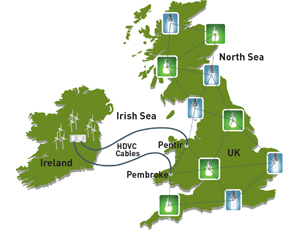
Battered by the global banking crisis, the Irish Republic could find some answers to its economic woes in the wind.
Ambitious plans to build two wind-energy projects, which would lay a total of 8,000 MW of power-transmission lines across the Irish Sea, could generate jobs and revenue while plugging some of the U.K.'s green-energy gap. However, not everybody in Ireland is happy at the prospect of thousands of turbines spreading across the country's midlands.
In recent weeks, U.S.-based investors secured an agreement from the U.K.'s National Grid plc to feed into its system output from a planned 3,000-MW Greenwire project in central Ireland. Greenwire's sponsor, Element Power Ltd., is backed by a $1-billion fund managed by Hudson Clean Energy Partners, Teaneck, N.J. Its plan would lead to the construction of 40 turbine clusters spread over some 9,000 sq kilometers of central Ireland, west of Dublin. Work on the estimated $10-billion project could start in 2015, with the first 2,000-MW subsea link shipping power to North Wales in 2017. A 1,000-MW link to South Wales would follow a year later.
A similar agreement was later sealed with National Grid for the proposed 5,000-MW Mainstream project, sponsored partly by Chinese and Portuguese companies. If fully built, the two projects would raise the republic's installed onshore wind-power generating capacity by a factor of four.
Besides starting a turbine rush, the Greenwire and Mainstream projects would create a proliferation of 200-km-long, high-voltage, direct-current subsea links to the Welsh coast. Until last month's inauguration of the $780-million, 500-MW link with the U.K. by Eiregrid plc, the Irish grid operator, the two countries were electrically unconnected, except indirectly through a line between northern Ireland and Scotland.
Officials from both project companies now are negotiating land rights for turbine sites. Greenwire estimates it will need about 11 sq km of space for the 700 or so turbines it would put up, says a company spokeswoman. However, she adds, Greenwire's final go-ahead depends on how the U.K. government's energy-market reforms, now in draft legislation, will treat renewables.
For the U.K., Greenwire and Mainstream would help plug a growing energy gap while sidestepping public unease in Britain about the proliferation of wind turbines and power lines. National Grid forecasts a 20,000-MW need for new generating capacity in order to replace the fossil and nuclear plants that are being retired.
And the new powerplant mix must comply with European Union law, which requires the U.K. to generate at least 15% of its consumed energy from renewables by 2020, up from 3% in 2009.
But while wind energy has government support, opposition in the U.K. is well established and is beginning to cross the Irish Sea. In a letter to British Prime Minister David Cameron earlier this year, more than 100 members of Parliament asserted the time has come to reduce subsidies for onshore wind power. “It is unwise to make consumers pay, through taxpayer subsidy, for inefficient and intermittent energy production that typifies on-shore wind turbines,” they wrote.
With 340 farms, the U.K. already has 5,000 MW of onshore wind capacity, according to the British Wind Energy Association. Another 84 farms, amounting to over 2,000 MW, are in construction; an additional 11,300 MW wait in the pipeline. Now, nearby Ireland is offering itself as a base for more development.
The British controversy has been noticed by emerging lobbies in the Irish Republic. Val Martin, national representative of the European Platform Against Windfarms, claims the big Irish projects are in breach of international environmental norms and not justified in cost-benefit terms.
Mike de Jong, a committee member of the republic's newly formed Campaign for Responsible Engagement With Wind Energy for Ireland, speaking personally, adds, “The U.K. is exporting its wind energy problem here because there's so much grief over there.”



Post a comment to this article
Report Abusive Comment